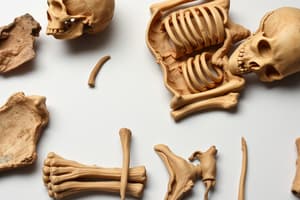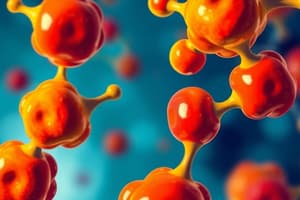Podcast
Questions and Answers
What is the biological profile?
What is the biological profile?
Data collected by bioarchaeologists and forensic anthropologists from the human skeleton to establish aspects of the biological profile.
Which of the following describes the aspects of a biological profile? (Select all that apply)
Which of the following describes the aspects of a biological profile? (Select all that apply)
- Sex (male, female, indeterminate) (correct)
- Age (adult, subadult) (correct)
- MNI (Minimum Number of Individuals) (correct)
- Ancestry (correct)
Sex determination is solely based on skeletal sexing methods.
Sex determination is solely based on skeletal sexing methods.
False (B)
What does sexual dimorphism refer to?
What does sexual dimorphism refer to?
The best site for sex determination is ___ morphology and metrics.
The best site for sex determination is ___ morphology and metrics.
Which skeletal indicators have the following accuracy for sex determination?
Which skeletal indicators have the following accuracy for sex determination?
What is the significance of the calcaneus length in sex determination?
What is the significance of the calcaneus length in sex determination?
Sex determination is more of an art than a science.
Sex determination is more of an art than a science.
What does the phenice method yield in terms of sex determination accuracy?
What does the phenice method yield in terms of sex determination accuracy?
The average age at which the last epiphysis of the clavicle fuses is around ___ years old.
The average age at which the last epiphysis of the clavicle fuses is around ___ years old.
What is the primary method for aging individuals based on cranial sutures?
What is the primary method for aging individuals based on cranial sutures?
What is the primary method used to examine the aging of the pubic symphysis?
What is the primary method used to examine the aging of the pubic symphysis?
What does the term 'biological race' refer to?
What does the term 'biological race' refer to?
Social race is defined by actual genetic similarities.
Social race is defined by actual genetic similarities.
What is a notable characteristic of White nasal apertures?
What is a notable characteristic of White nasal apertures?
Match the following groups with their corresponding nasal root shapes:
Match the following groups with their corresponding nasal root shapes:
What is the nasal spine projection for white individuals?
What is the nasal spine projection for white individuals?
What is the Nasal Still Projection or Shape for black individuals?
What is the Nasal Still Projection or Shape for black individuals?
What describes the maxillary palate shape for Asian individuals?
What describes the maxillary palate shape for Asian individuals?
What trait is commonly linked to shovel-shaped incisors?
What trait is commonly linked to shovel-shaped incisors?
What is stature estimation used for in forensic anthropology?
What is stature estimation used for in forensic anthropology?
What affects living biological stature throughout the day?
What affects living biological stature throughout the day?
What is reported forensic stature?
What is reported forensic stature?
How might cadaver stature differ from living stature?
How might cadaver stature differ from living stature?
What is the equation used in Trotter and Gleser stature estimation?
What is the equation used in Trotter and Gleser stature estimation?
What sample size was used in the Trotter and Gleser stature estimation study from WWII?
What sample size was used in the Trotter and Gleser stature estimation study from WWII?
What does the stature estimation example 2.38*(43.0) + 61.41 calculate?
What does the stature estimation example 2.38*(43.0) + 61.41 calculate?
Study Notes
Biological Profile Overview
- Biological profile encompasses data gathered by bioarchaeologists and forensic anthropologists from human skeletons to establish physical characteristics.
- Key components include determining whether remains are human or non-human, the minimum number of individuals (MNI), sex, age, stature, ancestry, and unique identifying features.
Sex Determination
- Skeletal sexing leverages anatomical differences; females exhibit distinct pelvic modifications to facilitate childbirth.
- Sexual dimorphism indicates men are generally larger and more robust by 10-15% compared to women, with consistent size differences visible across skeletal structures.
- Accuracy rates for sex determination are highest for pelvis morphology (90%), followed by skull morphology (85%), and long bone metrics (80%).
Methods for Estimating Sex
- The Phenice method utilizes three pelvic features for sex estimation, claiming up to 95% accuracy.
- Non-metric techniques include observing the shape of the obturator foramen and the curvature of the sacrum.
- General group patterns are essential for accurate estimation; analysts must evaluate multiple skeletal features to enhance accuracy.
Age Estimation
- Age estimation techniques focus on morphological changes in the skeleton, adapted from well-studied population data.
- Aging trends include rapid changes during infancy and adolescence, with changes shifting toward degenerative patterns post-20 years.
- Basic age classes categorize individuals from prenatal through old adulthood.
Dental and Skeletal Age Indicators
- Dental development indicators, particularly in children and young adults, are highly reliable due to documented eruption sequences influenced by nutrition and health.
- Epiphyseal fusion for age estimation follows a predictable sequence, with late fusions occurring in specific bones around ages 21-30.
Pubic Symphysis Aging
- Six distinct phases characterize changes in the pubic symphysis through aging, with specific morphological features at each stage identified for age estimation.
- The accuracy decreases for individuals over early adulthood; there is less precision in assessing older adults using traditional aging methods.
Cranial Suture Fusion for Aging
- Cranial suture fusion is another method for estimating age, scoring landmarks to determine the extent of fusion and assigning age ranges based on established criteria.
- Method blends characteristics of both forensic and archaeological approaches, adjusting for broader variability in older age categories.
Biological vs. Social Race
- Biological race refers to groups capable of interbreeding and producing fertile offspring, emphasizing that variation exists more within groups than between them.
- Social race involves cultural and physical characteristics that groups self-identify with, shaped by observable features and shared cultural traits.
Cranial and Facial Features
- Various cranial and facial measurements reveal distinct characteristics, including orbital shapes, nasal apertures, and cheek projections across different ancestral groups.
- Specific metrics categorize features such as facial profiles and nasion shapes which vary significantly among groups classified as White, Black, and Asian.
Additional Considerations
- Methods of biological profiling require careful assessment of multiple indicators to mitigate biases in estimations.
- Analysts must be aware of the limitations and potential overlap in skeletal indicators, as sex determination and age estimation often involve complex and nuanced assessments.### Shovel Shaped Incisors
- Trait characterized by a distinct shape of the incisors.
- More prevalent in Asian populations and those of Asian descent, although not exclusive to them.
- Provides some indication for assessing ancestry, but is not definitive on its own.
Stature Estimation
- Utilized in forensic anthropology to narrow down missing persons cases.
- Provides insights into the overall health of populations in bioarchaeology.
- Requires knowledge of sex and ancestry for accurate stature estimation.
Living Biological Stature
- Refers to the height of an individual during typical daily life.
- Individuals tend to be taller in the morning and shorter at night due to postural changes.
Drivers License Stature
- Refers to the height recorded when a driver's license is issued.
- Functions as a reference for law enforcement during missing person searches.
Cadaver Stature
- Indicates the stature of a body post-mortem.
- May reflect the individual's maximum height or their early morning stature.
Trotter and Gleser Stature Estimation Equations
- Equation: 2.38 * (Femur Length in cm) + 61.41 cm ± 3.27 cm.
- Based on data from WWII and Terry collections, no significant differences between left and right sides.
- Factors in measurements from a total of 12 bones.
Trotter and Gleser Stature Estimation Sample Size
- WWII data: 1200 male subjects (1115 white males, 85 black males).
- Terry collection: 725 total (225 white males, 260 black males, 63 white females, 177 black females).
- Korean War data includes 5374 males (4650 white, 573 black, 25 Asian American, 112 Mexican, 14 Puerto Rican).
Stature Estimation Example
- Calculation: 2.38 * (43.0) + 61.41 ± 3.27 leads to height range of 160.48 cm to 167.02 cm.
- Conversion to English units gives a height of approximately 5'4.6" ±1.3”, which translates to a range of 5'3.3" to 5'5.9".
Cranial Measurements
- Maximum Cranial Length measured between glabella and opisthocranion.
- Maximum Cranial Breadth assessed at the widest point of the skull.
- Bizygomatic Diameter measures the width of the zygomatic arches.
- Cranial Base Length from the nasion to the basion.
- Basion-Bregma Height from the foramen magnum to bregma.
- Basion-Prosthion Length spanning from basion to prosthion.
- Maxilo-Alveolar Length from prosthion to alveolon.
- Maxillo-Alveolar Breadth across the maxillary molars.
- Biauricular Breadth measures across the roots of the zygomatic processes.
- Upper Facial Height from nasion to prosthion.
- Upper Facial Breadth measures between the frontomalar sutures.
- Minimum Frontal Breadth assessed across the frontotemporale points.
- Nasal Height from the nasion to the midpoint of nasal notches.
- Nasal Breadth measured at the maximum width of the nasal aperture.
- Orbital Breadth measures from dacryon to ectoconchion.
- Orbital Height assessed between superior and inferior orbital margins.
- Biorbital Breadth measures between right and left ectoconchion.
- Interorbital Breadth measures between right and left dacryon.
- Frontal Chord measures from nasion to bregma.
- Parietal Chord measures from bregma to lambda.
- Occipital Chord spans from lambda to opisthion.
Studying That Suits You
Use AI to generate personalized quizzes and flashcards to suit your learning preferences.
Description
This quiz explores the concept of biological profiles within forensic anthropology, focusing on sex determination methods and skeletal indicators. It includes questions about sexual dimorphism and the accuracy of different morphological assessments. Test your knowledge on how biological characteristics can be analyzed to establish profiles.




